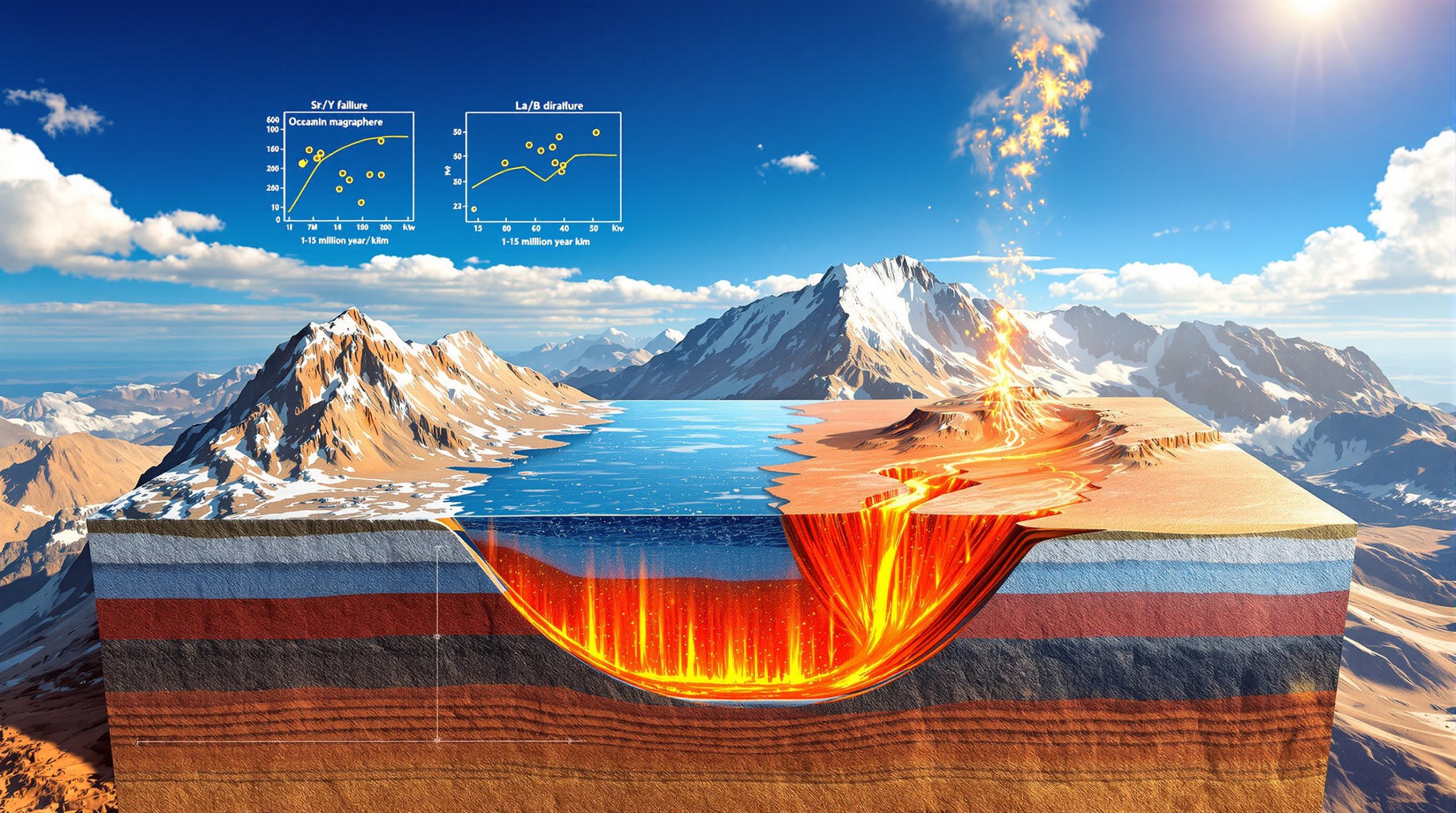Continental collision zones represent some of Earth's most dynamic geological environments, where immense tectonic forces reshape the planet's surface and generate diverse magmatic processes. While traditional models have long emphasised the role of volcanic arcs in crustal formation, emerging mineral exploration insights reveal a more complex picture of post-collisional magmatism that challenges conventional understanding of how continents evolve.
The recognition that not all granitic rocks formed through typical subduction zone processes has prompted geologists to reconsider fundamental assumptions about crustal development. This shift in perspective has profound implications for understanding how Earth's continental crust has evolved over billions of years, particularly through processes that occur after major tectonic collisions have ceased.
What Is Slab Failure Magmatism and Why Does It Matter?
Defining the Geological Process
Slab failure magmatism represents a distinct post-collisional magmatic process that occurs when oceanic plates detach from continental margins following major tectonic collisions. This phenomenon differs fundamentally from traditional arc magmatism in both its timing and geological setting, typically manifesting between 1 and 15 million years after continental collision events have terminated active subduction.
The process begins when unsubductible terranes or continental masses arrive at subduction zones, creating conditions that prevent further downward motion of the oceanic plate. This geometric constraint forces the subducting slab to break off or detach, creating opportunities for magma generation under entirely different conditions than those found in active volcanic arcs.
The Collision-Breakoff Mechanism
The transition from active subduction to slab failure involves several critical stages that fundamentally alter the magmatic environment. During normal subduction, oceanic plates descend continuously beneath continental margins, maintaining steady-state conditions for arc volcanism. However, when collision occurs, this equilibrium becomes disrupted.
| Characteristic | Arc Magmatism | Slab Failure Magmatism |
|---|---|---|
| Timing relative to collision | During active subduction | 1-15 million years post-collision |
| Depth of source melting | ~30 km (plagioclase stable) | >40-50 km (garnet stable) |
| Geochemical signatures | Low Sr/Y, Low La/Yb ratios | High Sr/Y, High La/Yb ratios |
| Tectonic setting | Compressional convergent margin | Extensional post-collision environment |
The mechanical process of slab detachment creates unique conditions for magma generation. As Jeff Ter from the University of Puget Sound explains, when unsubductible terranes like the Cletia terrain arrived in the Pacific Northwest, subduction was terminated and the oceanic plate was forced to break off, initiating a fundamentally different type of magmatic process.
Global Significance in Crustal Evolution
Slab failure magmatism has played a crucial role in continental crust formation since the Early Proterozoic, contributing significantly to the rapid recycling and modification of crustal materials. The process provides a direct pathway for converting mafic oceanic crust into more evolved, continental-type magmas without the intermediate steps typically required in fractional crystallisation models.
Research by Hildebrand and colleagues (2018) suggests that this mechanism has been operating for approximately 3.8 billion years, addressing what they term the "crustal composition paradox" – the question of how Earth's continental crust achieved its current felsic composition. Furthermore, their work indicates that slab failure magmatism may account for a substantial portion of continental crustal growth throughout Earth's history.
The global distribution of potential slab failure events spans multiple orogenic belts, including the Sierra Nevada, Coast Range batholiths, and numerous other major plutonic complexes. These occurrences suggest that the process represents a fundamental mechanism of crustal evolution rather than an isolated phenomenon.
How Does Slab Failure Create Unique Magmatic Signatures?
The Geochemical Fingerprint System
The identification of slab failure magmatism relies heavily on distinctive trace element signatures that reflect the depth and mineralogy of source regions. Two key ratios serve as primary diagnostic tools: strontium/yttrium (Sr/Y) and lanthanum/ytterbium (La/Yb), which together provide insight into the mineral assemblages present during melting.
The fundamental principle underlying these geochemical tracers lies in the compatibility relationships between trace elements and specific minerals. When certain minerals are present during melting, they selectively retain or exclude particular elements, creating distinctive signatures in the resulting magmas.
The La/Yb ratio serves as a particularly sensitive indicator of garnet involvement in source melting. Values exceeding approximately 10 indicate significant garnet participation, reflecting melting depths greater than 40-50 kilometres. This threshold represents a critical transition from shallow, plagioclase-dominated melting typical of volcanic arcs to deeper, garnet-bearing assemblages characteristic of slab failure environments.
Mineral Compatibility and Melting Depth
The behaviour of trace elements during melting depends critically on their ability to substitute into specific mineral crystal structures. Strontium, with its +2 charge and ionic radius within 15% of calcium, readily substitutes into plagioclase feldspar, making it a compatible element in shallow melting environments. Conversely, yttrium, with its smaller ionic radius and +3 charge, cannot effectively substitute into plagioclase and remains incompatible.
| Element | Plagioclase Compatibility | Garnet Compatibility | Result in Melt |
|---|---|---|---|
| Strontium (Sr) | Compatible (+2 charge, similar size to Ca) | Incompatible | Low Sr when plagioclase present |
| Yttrium (Y) | Incompatible (wrong charge, too small) | Compatible | High Y when plagioclase absent |
| Light REE | Generally incompatible | Incompatible | High in both scenarios |
| Heavy REE | Incompatible | Compatible | Low when garnet present |
Garnet exhibits the opposite compatibility relationships, readily accepting yttrium and heavy rare earth elements while excluding strontium and light rare earth elements. This creates a distinctive "flip" in trace element signatures between shallow arc-related melting and deeper slab failure melting.
The transition from basalt to eclogite at depths of 40-50 kilometres marks the critical depth where plagioclase stability gives way to garnet-pyroxene assemblages. This mineralogical transformation directly controls the trace element signatures observed in resulting magmas.
Distinguishing Slab Melts from Crustal Melts
While trace element ratios effectively identify the presence of garnet in source regions, additional tools are required to distinguish between slab melting and deep crustal melting. Oxygen isotope compositions provide crucial constraints, with mantle-derived melts typically displaying δ18O values around 6 per mille, while crustal materials show elevated values near 10 per mille.
Radiogenic isotope systematics, particularly strontium and neodymium isotopes, offer additional discrimination capabilities. However, these signatures can be modified during magma ascent through interaction with mantle materials, complicating interpretations. As Ter notes, trace element ratios tend to remain more stable during this interaction than isotopic compositions.
The integration of multiple analytical approaches becomes essential for robust identification of slab failure magmatism. Single analytical tools, while informative, lack the definitiveness required for unambiguous identification of these processes.
What Are the Tectonic Prerequisites for Slab Failure?
Continental Collision Dynamics
The initiation of slab failure magmatism requires specific tectonic conditions that fundamentally alter the stress regime at convergent margins. The arrival of unsubductible terranes represents the most common trigger for slab detachment, as these buoyant crustal fragments cannot be subducted into the mantle.
In northeastern Washington, the arrival of the Cletia terrain on the subducting oceanic plate terminated normal subduction approximately 52 million years ago. This collision immediately preceded a systematic sweep of igneous activity that progressed southwestward from Idaho across northeastern Washington, culminating around 46 million years ago.
The compression-to-extension transition marks a critical phase in slab failure development. Active subduction creates compressional stress regimes that maintain plate coupling, but terrain collision disrupts this equilibrium, leading to extensional conditions that facilitate slab detachment.
Pre-Collision Arc Systems
Understanding slab failure requires recognition of the pre-existing arc systems that operated before collision. Normal subduction zone magmatism results from water-driven melting in the mantle wedge above descending oceanic plates, generating magmas at depths of approximately 30 kilometres where plagioclase remains stable.
These pre-collision arc systems exhibit characteristic geochemical signatures:
• Low Sr/Y ratios reflecting plagioclase involvement in source assemblages
• Low La/Yb ratios indicating absence of significant garnet participation
• Basaltic to basaltic-andesitic compositions typical of mantle wedge melting
• Water-rich compositions reflecting slab dehydration processes
The contrast between these pre-collision signatures and subsequent slab failure magmatism provides crucial evidence for the temporal and genetic relationships between these processes.
Post-Collision Extensional Environment
Following slab detachment, extensional tectonics create conditions favourable for both slab melting and crustal modification. The removal of the downgoing plate allows asthenospheric mantle to upwell, potentially triggering additional melting processes.
Tectonic indicators of slab failure environments include:
• Rapid uplift and exhumation of metamorphic core complexes
• Development of coarse sedimentary basins reflecting active erosion
• Transition from syncollisional to post-collisional magmatic suites
• Regional extension perpendicular to former convergent margins
• Emplacement of magmas significantly inboard of former volcanic arcs
The flat slab geometry proposed for some regions, such as northeastern Washington, may enhance the extent and duration of post-collision magmatism. Unlike steeply dipping slabs that create relatively localised magmatic zones, flat slabs that subsequently detach can cause widespread mantle upwelling and crustal melting over broader areas.
Where Has Slab Failure Magmatism Been Documented?
Peninsula Ranges Batholith Case Study
The Peninsula Ranges Batholith in Southern California represents one of the most thoroughly studied examples of potential slab failure magmatism. This Lower Cretaceous magmatic complex, formed approximately 100 million years ago, displays a systematic west-to-east geochemical zonation that has intrigued geologists for decades.
Gay and Silver's pioneering 1987 study identified three geochemically distinct belts within the batholith – western, central, and eastern zones – each characterised by different rare earth element patterns and strontium concentrations. Critically, these compositional variations could not be explained through fractional crystallisation processes, indicating fundamental differences in source characteristics.
The temporal progression revealed by subsequent research shows older plutons in the western belt displaying arc-like signatures with low La/Yb and Sr/Y ratios. In addition, younger plutons in the eastern belt exhibit high ratios indicative of garnet involvement and deeper melting. This age-space relationship provides compelling evidence for evolving source conditions consistent with slab failure scenarios.
Northeastern Washington Eocene Plutons
The Eocene magmatic suite of northeastern Washington spans from 52 to 46 million years ago, representing a systematic southwestward migration of igneous activity following the accretion of the Cletia terrain. This temporal and spatial pattern strongly supports models of slab rollback and failure.
| Region | Age Range (Ma) | Collision Event | Magmatic Volume |
|---|---|---|---|
| Idaho (eastern) | ~52 | Cletia accretion | High |
| NE Washington (central) | 50-48 | Post-collision | Moderate to High |
| NE Washington (western) | 48-46 | Continued rollback | Moderate |
These Eocene rocks consistently display garnet-in-source signatures, with many samples showing La/Yb ratios exceeding the threshold value of 10. This contrasts sharply with modern Cascade arc rocks, which uniformly display low ratios consistent with shallow, plagioclase-dominated melting.
However, isotopic evidence from northeastern Washington presents complications for simple slab failure models. The oxygen isotope compositions consistently indicate crustal rather than mantle sources, and strontium-neodymium isotope systematics correlate with mapped terrain boundaries rather than showing uniform slab-like signatures.
Global Distribution Patterns
Potential slab failure events have been identified in numerous orogenic belts worldwide, spanning a range of ages from Archean to Cenozoic. The Taconic Orogeny of the Upper Ordovician represents one of the older recognised examples, demonstrating that this process has operated throughout much of Earth's history.
North American Cordilleran examples extend beyond the Peninsula Ranges and northeastern Washington to include portions of the Sierra Nevada batholith, Coast Range complexes, and potentially elements of the Idaho batholith. Each region requires individual evaluation based on local geological logging codes and analytical data.
The global perspective suggests that slab failure magmatism may account for substantial portions of continental crustal growth, particularly in post-collisional settings where terrain accretion has disrupted normal subduction processes.
How Do Scientists Identify Slab Failure Magmas in the Field?
Geochemical Discrimination Tools
The identification of slab failure magmatism requires a systematic analytical approach combining multiple geochemical tools. The primary discrimination method involves plotting Sr/Y versus La/Yb ratios on bivariate diagrams, where different fields correspond to different melting environments:
-
Low La/Yb + Low Sr/Y: Shallow melting with plagioclase residue (typical arc magmatism)
-
High La/Yb + High Sr/Y: Deep melting with garnet residue (potential slab failure)
-
Intermediate values: Mixed or transitional melting conditions
-
High La/Yb + Low Sr/Y: Possible amphibole-dominated sources
Modern analytical capabilities allow precise measurement of these trace element ratios, but interpretation requires careful consideration of analytical uncertainties and potential complications from magma mixing or crustal assimilation processes. Furthermore, rock chip sampling methods must be carefully designed to ensure representative results.
Isotopic Evidence Requirements
Complementary isotopic analyses provide essential constraints on source characteristics and magma evolution processes. Strontium isotope ratios (87Sr/86Sr) help distinguish between mantle and crustal sources, though complications arise when mantle sources have been modified by previous subduction events.
Neodymium model ages offer insights into the crustal residence time of source materials, potentially distinguishing between recently subducted oceanic crust and ancient continental basement. However, regional variations in basement composition can create complex isotopic landscapes that require careful geological context for proper interpretation.
Oxygen isotope compositions remain among the most reliable indicators of source characteristics, with mantle values around 6 per mille contrasting with crustal values near 10 per mille. The absence of intermediate values may indicate limited interaction between slab-derived melts and mantle during ascent.
Integrated Field and Laboratory Approaches
Successful identification of slab failure magmatism demands integration of multiple analytical approaches with detailed field observations:
• Trace element geochemistry: Primary discrimination using Sr/Y and La/Yb ratios
• Isotopic analysis: Source characterisation through Sr-Nd-O isotope systematics
• Geochronological constraints: Temporal relationships between collision and magmatism
• Regional geological mapping: Spatial relationships and tectonic context
• Petrographic analysis: Mineral assemblages and textures indicating source conditions
The combination of these approaches helps overcome limitations inherent in any single analytical method. Field relationships remain crucial for establishing the broader tectonic context necessary for robust interpretations.
What Challenges Exist in Slab Failure Research?
Distinguishing Crustal vs. Slab Melting
One of the fundamental challenges in slab failure research involves distinguishing between actual slab melting and deep crustal melting in thickened continental crust. Both processes can generate similar trace element signatures when garnet is present in the source region, creating potential for misinterpretation.
Thick continental crust (>40-50 km) can stabilise garnet at its base, allowing crustal melting to produce high La/Yb and Sr/Y ratios identical to those expected from slab melting. The northeastern Washington example illustrates this complexity, where garnet signatures reflect crustal thickening during orogenesis rather than slab melting.
The challenge lies in developing criteria that can reliably distinguish between these two scenarios, particularly in ancient orogenic belts where direct evidence for slab geometry may be lacking.
Isotopic overlap between potential sources further complicates discrimination efforts. Continental crust and subducted oceanic crust may display similar isotopic characteristics, especially when crustal materials have been recycled through previous tectonic cycles.
Regional Geological Complexity
The interpretation of slab failure magmatism must account for the complex geological histories typical of convergent margins. Multiple generations of terrain accretion, varying slab geometries, and diverse crustal compositions all influence the geochemical signatures preserved in magmatic rocks.
Flat slab versus normal subduction geometries create different conditions for post-collision magmatism. Flat slabs may cause more distributed melting and mantle upwelling, while steeply dipping slabs produce more localised effects. The northeastern Washington case suggests that flat slab geometry may enhance crustal melting over slab melting.
Terrain-specific isotopic signatures present additional complications. Different accreted terrains carry distinct isotopic fingerprints that can overprint or obscure potential slab-derived signatures. The correlation of isotopic compositions with mapped terrain boundaries in northeastern Washington exemplifies this challenge.
Temporal Resolution Issues
Dating precision becomes critical for establishing causal relationships between collision events and subsequent magmatism. The 1-15 million year timeframe typical of slab failure requires geochronological precision sufficient to resolve these relationships from background magmatic activity.
Distinguishing contemporaneous versus sequential events presents ongoing challenges. Multiple magmatic pulses may reflect different aspects of the same slab failure event or entirely separate processes. The Tuolumne Intrusive Suite in Yosemite Valley illustrates this complexity, with plutons spanning approximately 5 million years initially interpreted as comagmatic but now recognised as separate batches from evolving sources.
Preservation bias in the geological record favours younger, better-preserved examples over older ones. This creates uncertainty about the long-term significance of slab failure processes and their role in Precambrian crustal evolution.
Why Is Slab Failure Magmatism Important for Understanding Earth's Evolution?
Continental Crust Formation Mechanisms
Slab failure magmatism provides a direct pathway for converting mafic oceanic crust into felsic continental-type magmas, potentially explaining the compositional evolution of Earth's continental crust over geological time. This process offers greater efficiency than traditional fractional crystallisation models, which require extensive differentiation to achieve granitic compositions.
The mechanism addresses fundamental questions about crustal composition that have puzzled geochemists for decades. How did Earth's continental crust achieve its current intermediate to felsic composition when most mantle-derived magmas are mafic? Slab failure magmatism provides one answer through direct melting of subducted basaltic crust under conditions that favour felsic melt production.
| Process | Efficiency | Volume Potential | Compositional Control |
|---|---|---|---|
| Fractional crystallisation | Low | Limited | Variable |
| Slab failure melting | High | Substantial | Predictable |
| Crustal recycling | Moderate | Large | Source-dependent |
Research by Hildebrand and colleagues suggests that slab failure processes have operated for 3.8 billion years, potentially accounting for substantial portions of continental crustal growth throughout Earth's history. This long-term perspective places the process among the fundamental mechanisms of planetary differentiation.
Orogenic Belt Architecture
The timing and distribution of slab failure magmatism directly influences the architecture of orogenic belts, creating distinctive patterns of post-collisional magmatism that extend significantly inboard from former convergent margins. This spatial relationship helps explain the broad zones of granitoid rocks found in many ancient mountain belts.
Post-collisional magmatism associated with slab failure often coincides with the development of metamorphic core complexes and extensional structures. This relationship suggests fundamental connections between slab detachment, crustal extension, and the exhumation of deep crustal levels.
The process may also influence mineral deposit formation, as slab failure magmas can transport metals and fluids from deep crustal levels to shallow environments. Understanding these relationships has potential applications for resource exploration in post-collisional settings.
Plate Tectonic Evolution
Slab failure represents a critical component of the plate tectonic cycle, marking the transition from active convergence to post-collisional extension. The process influences long-term patterns of continental growth and the evolution of continental margins over geological time.
The mechanism provides insights into how continents grow through terrain accretion and subsequent magmatic processes. The relationship between collision, slab detachment, and magmatism creates predictable patterns that can be recognised in ancient orogenic belts worldwide.
Subduction zone termination through terrain collision represents a fundamental process in plate tectonics, and slab failure magmatism provides a window into the consequences of these major tectonic reorganisations.
What Are the Future Research Directions?
Analytical Technology Advances
Emerging analytical technologies promise to revolutionise the identification and characterisation of slab failure magmatism. High-precision isotopic techniques, including advances in mass spectrometry and sample preparation methods, will provide more detailed fingerprinting of source materials and magmatic processes.
In-situ mineral analysis capabilities, particularly through laser ablation methods, allow direct analysis of trace elements and isotopes in individual mineral grains. This approach can reveal details of magmatic processes not accessible through whole-rock analyses and help distinguish between different source contributions within single samples.
Machine learning applications show promise for automating geochemical discrimination and identifying subtle patterns in large datasets. These approaches may reveal previously unrecognised examples of slab failure magmatism or refine existing discrimination criteria.
Global Database Development
The development of comprehensive global databases of potential slab failure events will facilitate comparative studies and improve understanding of the process's significance in crustal evolution. Standardised analytical protocols and discrimination criteria will enhance the reliability of identifications across different research groups.
Research priorities for expanding this database include:
• Precambrian case studies: Investigating older examples to understand long-term crustal evolution
• Modern analogue studies: Examining active or recent collision zones for comparison
• Experimental petrology constraints: Laboratory studies of slab melting processes
• Numerical modelling: Thermodynamic and kinetic models of slab failure scenarios
• Regional integration: Comprehensive studies of major orogenic belts
Implications for Resource Exploration
Understanding slab failure magmatism has practical applications for mineral resource exploration, particularly in post-collisional settings. The deep crustal melting associated with these processes may concentrate certain elements and create favourable conditions for ore formation.
Porphyry copper deposits show associations with some slab failure environments, suggesting that these magmatic processes may contribute to metal endowment in post-collisional settings. The high oxidation states typical of slab-derived magmas favour copper mineralisation under appropriate conditions.
Rare earth element concentrations in slab failure magmas may exceed those in typical arc rocks, reflecting the involvement of garnet and other accessory minerals in source regions. This relationship suggests potential applications in critical mineral exploration, particularly when combined with comprehensive drill results interpretation and understanding of mineral deposit tiers.
Furthermore, geothermal energy potential in slab failure regions remains largely unexplored but may be significant given the extensive magmatic activity associated with these processes. The long duration of magmatism in some regions suggests sustained thermal anomalies that could support geothermal development.
Disclaimer: This analysis of slab failure magmatism is based on current scientific understanding and ongoing research. Geological interpretations may evolve as new analytical data become available and analytical techniques continue to advance. The identification of slab failure magmatism requires careful integration of multiple lines of evidence, and alternative interpretations may be valid for specific localities or circumstances.
Ready to Capitalise on Australia's Next Major Mineral Discovery?
Discovery Alert's proprietary Discovery IQ model delivers instant notifications on significant ASX mineral discoveries, empowering investors to identify actionable opportunities before the broader market responds. Explore the platform's track record of major discoveries and their exceptional returns by visiting Discovery Alert's discoveries page, then begin your 30-day free trial to secure your market-leading advantage.




